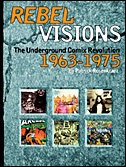|
Rebel Visions: The Underground Comix Revolution 1963-1975
review by Mike Baron By Patrick Rosenkranz, published by Fantagraphics Books, price $39.95 Here's a fat, satisfying, coffee-table sized book detailing the wild ride commenced by underground comics during the Age of Aquarius. Rosenkranz has interviewed most of the principles extensively, and it is their commentary that makes the book. This is an excellent history of the movement, often couched in the creators' own words. The author began his interviews in 1969 with Kim Deitch. The period covering Gilbert Shelton's experiments at the University of Texas in Austin are particularly revealing, showing the nexus of avoiding the draft, the burgeoning alternative counter-culture, and how college newspapers created a fertile breeding ground for a new type of cartooning. 
Artist after artist relates how he was drawn to San Francisco, aided in no small part by the rock scene, which provided a steady market for the type of psychedelic art pioneered by Stanley Mouse (more active than ever these days), Rick Griffin (who began his career in surfing mags), and Victor Moscoso. R. Crumb landed among these innocents like a hydrogen bomb. His Zap #1 is generally considered the start of the underground comics movement, although Shelton and others had preceded him in college newspapers. You can feel Crumb's confusion as he splits with his wife Dana, hooks back up with her, splits with her again, hooks back up again. Until we get a full-throated biography, Rebel Visions does an excellent job tracking his career. Rosenkranz repeats the now familiar story that it was actually S. Clay Wilson who freed Crumb's id. Crumb took one look at Wilson's over-the-top sexuality and asked, "Why should I censor myself?" I met Denis Kitchen in 1969 when he was trying to launch the Bugle-American in Madison and Milwaukee, and got to know his stable of Midwestern artists. Rosenkranz notes that the talented artist Jim Mitchell served five years in a Mexican prison for smuggling marijuana. This is deep stuff, never before covered. I've often asked Denis over the years what became of Mitchell, but no one knows. Rosenkranz is more thorough dealing with important, lesser-known luminaries such as Rand Holmes, Jay Lynch, Skip Williamson, and George Metzger. Some of these artists, Metzger in particular, deserve their own book. Graphically, the book delivers a Whitman's sampler of the underground movement, leaving you wanting more. It is a handsome book, filled with illustrations, but there simply isn't enough space to do these artists justice. For example, although Robert Williams gets plenty of space, we never see any of his full-size paintings. I think its important to show into what he evolved. There's probably more Crumb than anyone else, and it barely scratches the surface. Rosenkranz has done a good job showing us the early stages of the movement with many full-color reproductions. The book leaves you wanting more, but in a good way. At least virtually all of Crumb is available in reprint. Now if Fantagraphics would do the same for Holmes, Metzger, et al. Mike Baron is the creator of the award winning comic book Nexus and during his career has written an enormous variety of comics from The Flash to The Punisher. His first novel, Witchblade Demons has just been published and he is currently writing an Escapist story for Dark Horse Comics. Visit our Comic Book News Archive. |